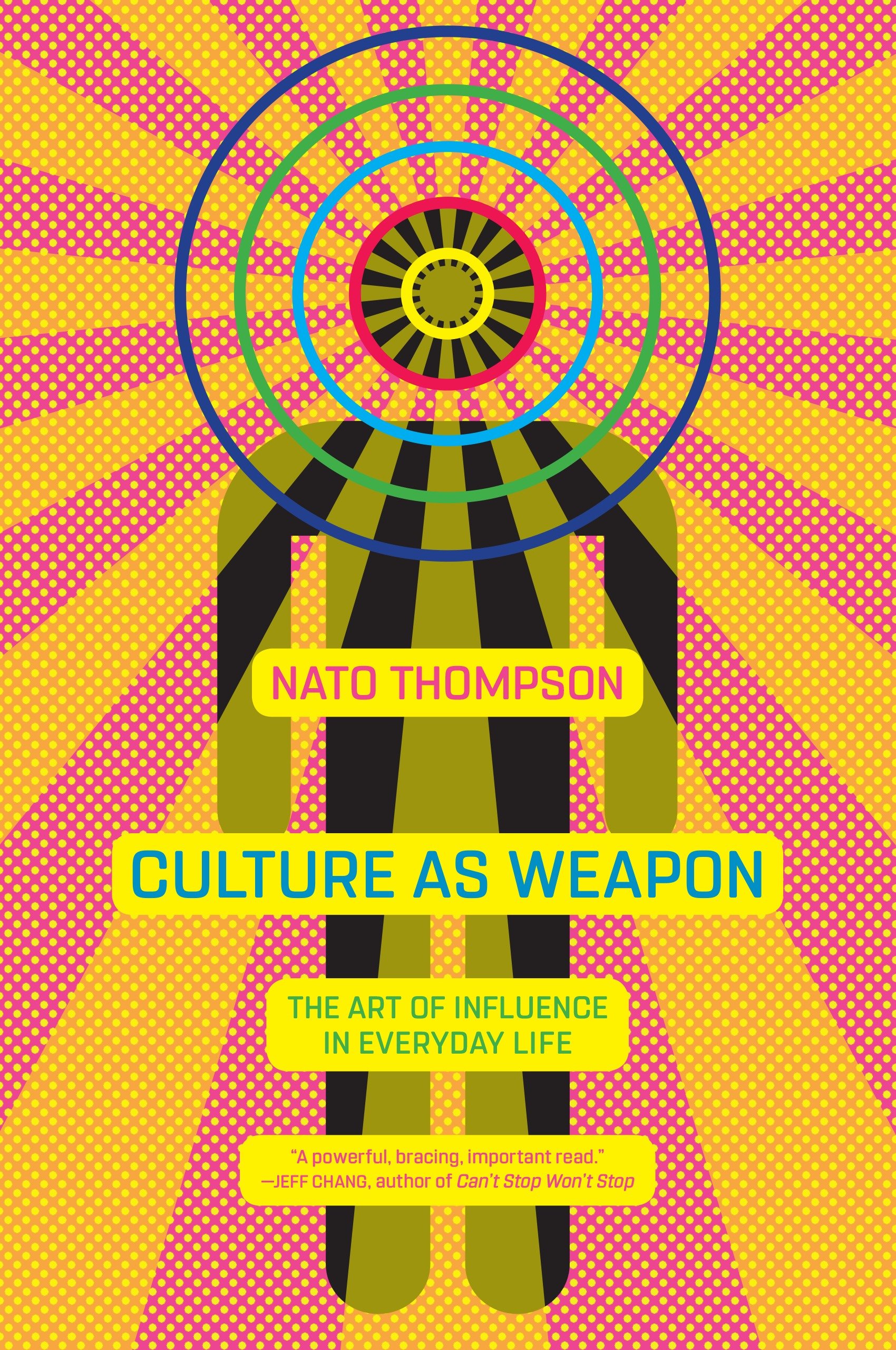The Art of Influence in Everyday Life: Culture as Weapon
14.00 JOD
Please allow 2 – 5 weeks for delivery of this item
Add to Gift RegistryDescription
One of the country’s leading activist curators explores how corporations and governments have used art and culture to mystify and manipulate us.The production of culture was once the domain of artists, but beginning in the early 1900s, the emerging fields of public relations, advertising and marketing transformed the way the powerful communicate with the rest of us. A century later, the tools are more sophisticated than ever, the onslaught more relentless. In Culture as Weapon, acclaimed curator and critic Nato Thompson reveals how institutions use art and culture to ensure profits and constrain dissent–and shows us that there are alternatives. An eye-opening account of the way advertising, media, and politics work today, Culture as Weapon offers a radically new way of looking at our world.
Additional information
| Weight | 0.27 kg |
|---|---|
| Dimensions | 1.78 × 13.97 × 21.09 cm |
| PubliCanadation City/Country | USA |
| book-author1 | |
| Format | Paperback |
| Language | |
| Pages | 288 |
| Publisher | |
| Year Published | 2018-3-6 |
| Imprint | |
| ISBN 10 | 1612196802 |
| About The Author | NATO THOMPSON is chief curator at Creative Time, one of New York's most prestigious and exciting art organizations. He is the editor of The Interventionists: A Users' Manual for the Creative Disruption of Everyday Life; Experimental Geography: Radical Approaches to Landscape, Cartography, and Urbanism (Melville House), and Ahistoric Occasion: Artists Making History. And he is the author of Seeing Power (Melville House). |
“Explores the ways in which the tools of culture are deployed to do everything from sell iPhones to wage war…The book’s landing during the early days of the Trump administration couldn’t have been more impeccable…Culture as Weapon provides a compelling manual for determining how the manipulation begins.”—LOS ANGELES TIMES“Art has played a huge role in shaping modern society…But In Culture as Weapon, Nato Thompson argues that art—or more specifically, the criticism of art—can also be an invaluable way to score political points.”—TIME“Energetic, briskly paced, and well-researched…[Thompson] voids cliché and succeeds in raising awareness of the cultural forces that shape brand preferences and political allegiance.”—PUBLISHERS WEEKLY “[Thompson explores] how persuasive cultural mechanisms are encoded in broader social structures, from high art to war-planning…A precisely written critique of cultural manipulation in our daily lives.”—KIRKUS REVIEWS“[Thompson] explores the intersections of art, culture, and manipulation in society…Informative, profound, and alarming.”—BOOKLIST/American Library Association“When it comes to living in a democracy, Nato Thompson argues, nothing affects us more directly and more powerfully than culture.”—THE ATLANTIC“Thompson outlines the ways that all forms of culture can be deployed to appeal to our emotional selves.”—ARTNET NEWS“A crucial read about the way PR methods have sunk into every aspect of our lives…This book makes the culture wars seem even deeper, more far-reaching and more crucial than ever before.”—FLAVORWIRE“With illuminating perspicacity, Thompson explores the myriad ways unmarketable art survives in a society where political divisions, the aesthetics of advertising, and the mistaking of finely-tuned commercial branding for communal bonding drive modern American culture.”—THE CULTURE TRIP“Timely and significant.”—COACHELLA VALLEY WEEKLY“Culture as Weapon is a brilliant and scathing take no prisoners critique of contemporary culture. Spanning military occupation, capitalism masquerading as charity, and personal computing, Nato Thompson shows us the dark side of how culture is deployed to fortify power.”—Laura Poitras, filmmaker, Citizenfour“Yes, art 'works,' as the saying goes, but what work does it do? Does it make us wiser? Does it help us to understand ourselves? Not necessarily. As Nato Thompson shows us in this wide-ranging and provocatively written book, art sometimes takes us down a different road entirely. Art sells; art gentrifies; art puts a nice glossy shine on the neoliberal project. Read it and discover exactly how mistaken is our assumption that human creativity brings us always closer to some earthly utopia.”—Thomas Frank, author of What's The Matter With Kansas? “One of the most compelling curators and thinkers in the arts today turns his discerning eye to the new politics of the culture war. Roaming widely from Hollywood to Washington D.C., Madison Avenue to Mosul, while unpacking 'creative city' boosterism, the new 'corporate sociability,' and the 21st century charity complex, his provocative argument is that the powerful have learned from artists the tools and tactics of the counterculture—and we are not the better for it. A powerful, bracing, important read.” —Jeff Chang, author Can't Stop Won't Stop“Culture as Weapon reveals the profound social function that art plays. Thompson explores how art is situated at this nexus of utopic vision and social reality, and suggests how we can navigate a landscape where art, culture, and its producers and consumers, seem to be emerging. This is the book that we have been waiting for.”—Hans Ulrich Obrist, artistic director of the Serpentine Galleries, London“Thompson efficiently demonstrates how culture can be turned into a set of tools and tactics that allows those in power to quietly manipulate the impressionable, irrational and social creature that we are…[Culture as Weapon] is informative and entertaining. It is also troubling, thought-provoking and impossible to read without thinking about Trump.”—We Make Money Not Art“Brilliant…Thompson's main point is not that we should reject culture as a method of positive change or resistance, but that we need to be mindful of its limitations and prepared for systems of power to respond in kind.”—Josh Cook, author of An Exaggerated Murder |
|
| Excerpt From Book | Culture as Weapon: The Art of Influence in Everyday Life INTRODUCTIONAs every artist knows, Plato argued that artists should be banned from society. A believer that we live in a pale shadow of a world of perfect forms, he felt that the arts were dangerous imitations, three degrees removed from the world of ideal forms. He feared that the arts could stir the passions of the populace, muddying the objective rationality required in the republic.Plato’s opinion certainly runs counter to the operating logic of society today. The United States is a consumer society awash in the products of culture. I consider movies, online programming, video games, advertisements, sports, retail outlets, music, art museums, and social networking all a part of the arts, as they all influence our emotions, actions, and our very understanding of ourselves as citizens. And as much as politicians would never call themselves artists, they all understand the value of showmanship and public relations when it comes to the machinations of governance. But as much as I would like to simply discard Plato’s warning, it certainly haunted the writing of this book. For that artistic technique of stirring the passions and appealing to the intimate side in each of us has become inseparable from power.In Culture as Weapon, I do not seek to uncover a cultural conspiracy that puppet masters deploy culture to brainwash us. Instead, I want to explain the ways in which those in power have to use culture to maintain and expand their influence, and the role that we all play in that process. Throughout the twentieth century and into the contemporary era, the world has witnessed the realization of age-old avant-garde demand that art become part of the everyday. Art and life have in fact merged.At first blush, this train of thought strikes us as fairly obvious. We understand that media is a crucial part of how the world works. We understand that advertising has creeped into many facets of consumer life. And we even understand that spin has come to be a critical part of the political landscape. Ultimately, we understand that message-craft and manipulating the world to cater to how we feel has ingrained itself into every mechanism of power. So, if none of this is new, why write a book?Simply stated, the industries dependent on shaping how we think have reached an unprecedented scale. As a global strategy deployed at every level, culture has become a profound, and ubiquitous, weapon. Communications and public-relations departments have become essential parts of every business. Global spending on advertising reached nearly $600 billion in 2015.1 One in seven people on the planet are on Facebook. By 2011, 91 percent of children ages two to seventeen played video games.2 In the United States, teenagers spend nearly nine hours a day looking at screens.3 And those are just the measurable aspects of culture’s exponential growth. There are countless philosophical questions to be asked: How has the role of music in everyday life changed in the last one hundred years? How many scripted television shows can one watch? How many more creative ways are there to shape the city?And yet, we remain unappreciative of just how dramatic this shift in the techniques of power has become. In particular, we continue to read the world as though it still has one foot solidly planted in the realm of reason. It is in our global DNA to identify as rational subjects. But perhaps, this Enlightenment-era thinking could use a heavy pause as we discover just how emotional, affective, we truly are.Certainly this turn away from an Enlightment belief in our own rationality stands on the shoulders of great thinkers from Adorno to Gramsci, from cultural studies of the Birmingham school with figures such as Stuart Hall, Dick Hebidge, and Raymond Williams, to more contemporary, less structuralist, approaches by Judith Butler. But while I invoke some of these theories in the book, my main goal is to make sense of just how affective, how culturally savvy are the institutions—Apple stores, Facebook, real-estate moguls, to name just a few—that we confront daily.I hope to demonstrate a broad-strokes reading of the uses of culture. We will define culture simply. And in doing so, we begin to see it everywhere, from counterinsurgency tactics in the Iraq War to the origins of IKEA to rock bands singing for aid for Africa to the design of the Mac to the war on drugs. It is a motley assemblage of seemingly disparate phenomena—and intentionally so. For power is visible in the hands of our elected officials as often as it is hidden in a package of inanity. The many forms of power in our world have sophisticated approaches to reaching that very needy, fearful, and social creature we call ourselves.One of my key hopes for this book is to echo something that Walter Lippmann had voiced long ago: that democracy is a fallible project rhetorically dependent on a rational subject, who, quite frankly, does not exist. In fact, the illusion of the rational subject has been extremely helpful in hiding the totality of these techniques. Understanding the power of association and the uses of emotion can explain a U.S. election better than a lens of capitalism. Just as Marxist philosophers in Britain sought to understand why the British populace turned away from Labour through the rise of Margaret Thatcher, just as Thomas Frank struggled to understand why working-class Kansas voted Republican, and just as, further back, Karl Marx asked why the French people rallied around the tyrant Louis Bonaparte in 1852, I want to make a further contribution to the cultural study of why people don’t act rationally.While it is certainly demonstrable that one can encourage a consumer to purchase Coca-Cola through a clever, large-scale advertising campaign, it remains unclear how the aggregate of advertising approaches collectively affect the opinions and actions of that consumer. It also remains unclear the secondary results of cultural manipulation when deployed by politicians, whether in the case of war abroad or at home. These cumulative effects of the deployment of affect has made for a very messy social terrain. It is sort of like a greenhouse effect of cultural production that changes our sense of the world around us.Some compelling implications arise when we read power through its use of culture. For example, power has contributed to the strategies and vulnerabilities of social movements by manipulating media and public perception. Media activism and social movements that cull from the techniques of advertising to make a larger point have a long history, but it is useful to appreciate the double-edged nature of deploying culture. Simple facts—that fear motivates faster than hope, that appeals to emotion do not rely on the truth, or that rationality need not drive enthusiasm—make the terrain of activism that uses culture more precarious.From an arts perspective, I would like to place what is considerated the traditional arts (theater, visual arts, dance, and film) into conversation with not only the commercial arts, but also public relations and advertising. In this way, we can position this more broad definition of art as something that has a potentiality for being both deeply coercive and absolutely powerful. After a century of cultural manipulation, it would be naive to discuss art without simultaneously discussing the manner in which art is already deployed by power daily. With real-estate developers and the tech boom both boldly embracing the power of art to change society, with the deployment of the use of the term creative to rebrand innovative capitalist design as an art, one has to appreciate, and perhaps second-guess, just how far art has come. By demystifying the inherent good of art, one can place art in the same conversation as other phenomena of daily life.As much as this book is about public opinion, I know that public opinion is not everything. In fact, I would say a large part of power doesn’t depend on public opinion. The Fortune 500 companies list Walmart at number one with its basic approach of low-cost consumer goods being its strategy. The second company is ExxonMobil, who continues to churn out oil for an energy dependent globe. For both of these companies, power resides in getting the basic goods to people while controlling that market. Yes, they advertise and to some degree shape their brand, but that isn’t the formula for their massive sales. So while the uses of culture have grown immensely, they don’t exist in a vacuum.That said, how we understand the world certainly remains a key part of our collective journey. It’s an obvious thing to say. But perhaps we have to appreciate that we, as evolutionary creatures, are ultimately fearful social beings who try our best to grapple with phenomena beyond our ken. We try to understand everything from climate change to global war to capitalism to biotechnology. But we can only process that information through the lens of our intimate selves. We interpret the world by way of our personal needs and desires, and so we are vulnerable to larger powers who know how to speak to those needs. |
Only logged in customers who have purchased this product may leave a review.






Reviews
There are no reviews yet.